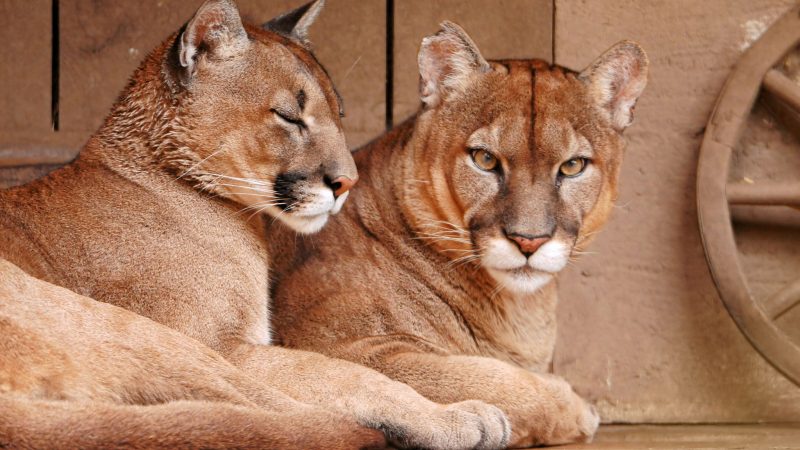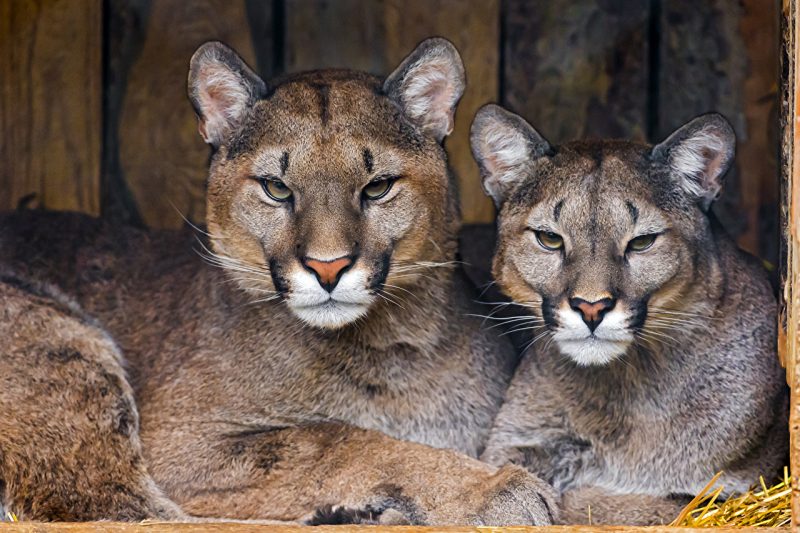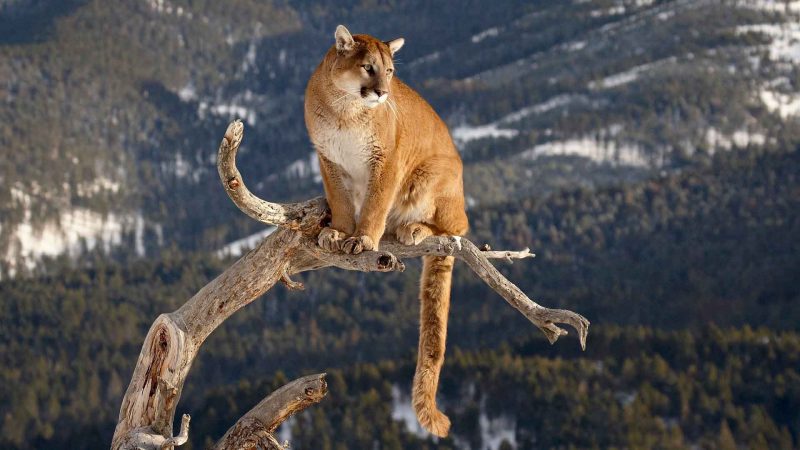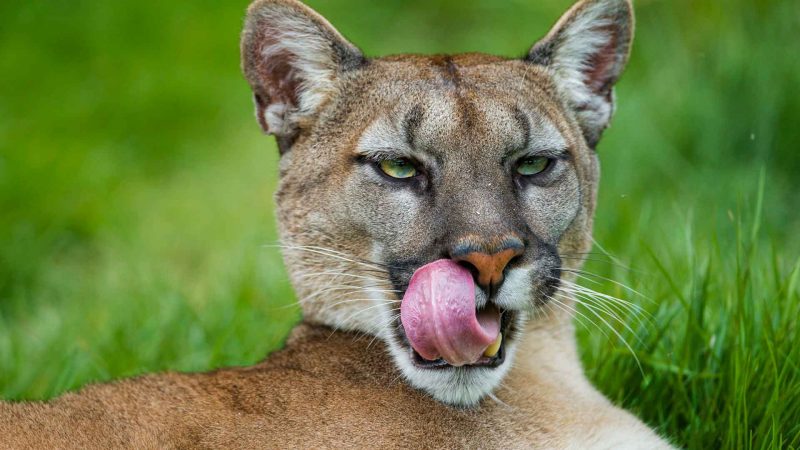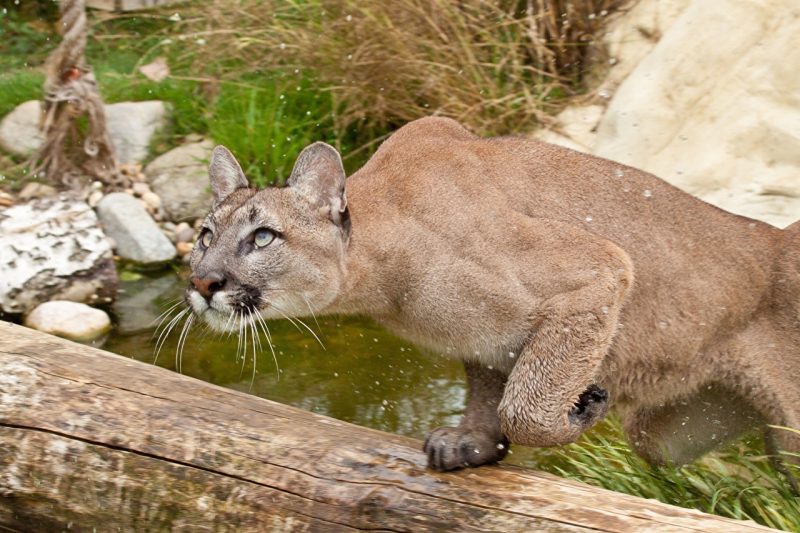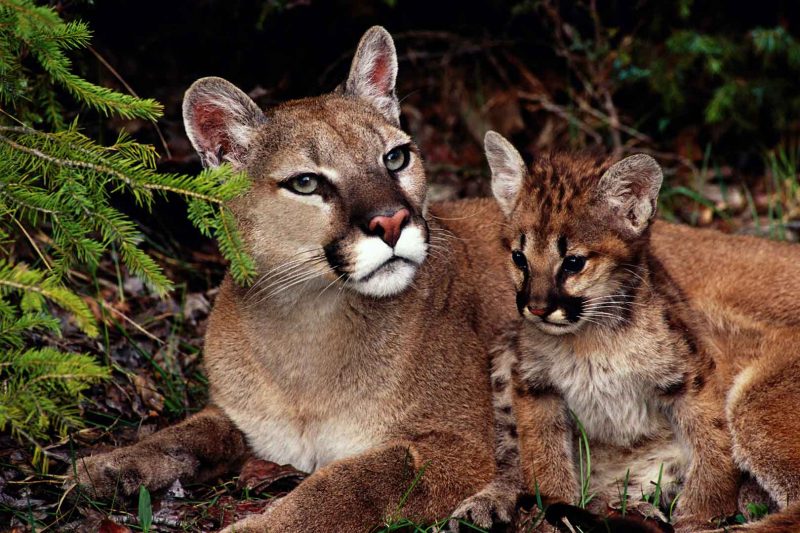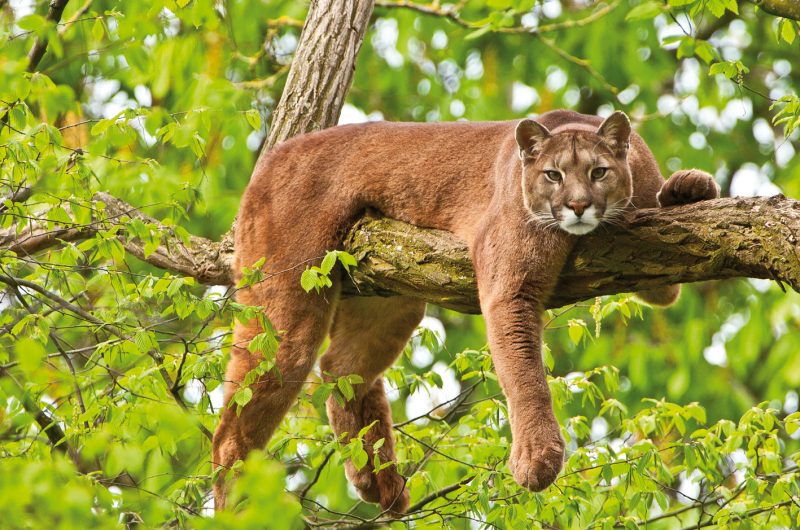Puma is a magnificent representative of the cat family, striking in its strength, grace and beauty. For many years, this predator has been capturing the continued interest of naturalists. Where does the cougar live, and what kind of lifestyle does this big cat lead?
Material Content:
On which continents, in which countries does the cougar live
Puma, also called cougar or silver lion, along with the spotted jaguar, is considered the only predator of the feline family living in America. The area of the cougar occupies almost the entire continent. Centuries ago, cougars lived on the territory occupying the south of present-day Argentina and reaching Alaska and Canada. The modern range of animals has narrowed significantly: they can be found in North and South America, and on the northern continent the animal does not live everywhere, but only in the western part and in Florida. Cougars do not like northern latitudes and prefer to settle in mountainous areas, avoiding plains, although they are able to live in lowlands, grassy or swampy territories. Cougars also inhabit tropical coniferous forests.
Numerous studies have led to the conclusion that the cougar lives where the distribution range of wild deer is noted. This is not surprising, because these herbivores are the main hunting objects of the silver lion.
It is interesting! In the modern animal kingdom, there are 6 subspecies of cougars, 5 of them live in Latin America. Cats living in the open spaces of North America are called the North American subspecies.In Argentina, the so-called Argentinean mountain lion lives, in the vicinity of Costa Rica, there is another very small subspecies of the cougar, which can hardly withstand the competition of jaguars. There are also South American subspecies of cougars living in Peru, Venezuela, Colombia, and northern Brazil.
Description, size and life span
Silvery lions can reach a length of 2 m and a height at the withers of 1 m. Adult individuals weigh 80-100 kg (males) and 50 kg (females).
The coat of the cougar is short and thick, has a reddish tint. In this case, the upper part of the cat’s body is darker than the lower, and black blotches appear on the ears and muzzle.
Cougars have strong teeth and jaws, it is from them, as a rule, that you can determine the age of the predator.
The hind legs are more massive than the front, which helps the cougar climb trees and jump from branch to branch. Their hind limbs are equipped with four fingers, while the forelimbs are equipped with five.
A strong and long tail helps them keep their balance while jumping. The length of a cat's jump can be 7 m, and a height of 2 m. In pursuit of prey, cougars can accelerate to 50 km / h. In the wild, the cougar will help live about 20 years.
Predator lifestyle
Cougars are solitary predators, unless, of course, we are talking about couples about to start offspring. But even such tandems break up after the fertilization of the female, and the cats return to their solitary stay.
These large animals are active both night and day, but prey mainly at dusk. Territories that they consider to be their own, cougars mark with urine and specially scratch trees.
Dexterity and mobility allow them to easily climb the highest branches of trees, hunting for monkeys. It will not be difficult for this predator to catch even a swift-footed ostrich with a nanda. In the wild, the cougar has virtually no enemies, only a sick animal can become prey for a jaguar, alligator or wolves. Cougars in every possible way avoid meeting a person and attack him only with a real threat coming from the two-legged.
Nutrition in the natural habitat
The hunting grounds of the puma are quite extensive and can be 100-700 km2. While hunting, the cougar lies in ambush and abruptly jumps out on unsuspecting prey. It is difficult for them to cope with large animals, for example, bulls. Therefore, the predator goes to the trick, using the factor of surprise. Situated on top of the prey, the cougar presses on its neck and back with all its weight. A huge cat either digs into the victim's throat or breaks her neck with pressure from her body.
However, the mountain lion does not disdain with smaller animals.
The following mammals may be included in the cougar diet:
- various varieties of deer;
- mice, rabbits;
- coyotes, lynxes;
- possums, sloths;
- porcupines, beavers;
- squirrels, raccoons, skunks.
It is interesting! In hungry periods, cougars can commit acts of cannibalism by eating their relatives.
If necessary, the cougar will also help to eat birds, fish, snails or insects. The fearless cat, hunting, rushes at adult grizzly bears and alligators. Cougar does not distinguish between wild animals and those living next to humans, so it can hunt for poultry or livestock. Even cats or dogs can fall under the hot paw of a silver lion.
Did you know? A year, one adult cougar can eat from 860 to 1300 kg of meat. In the total mass, a similar figure is about 50 ungulates. Cougars have the peculiarity of destroying production with a margin, i.e. in an amount far exceeding what they need to satisfy their hunger. The Indians who found out about this often watched the predator, taking away the game that was buried by them. However, the latter often remained completely untouched.
Breeding and rearing offspring
A certain time frame regarding breeding is typical only for North American cougars: they mate from December to March.For the remaining species of these wild cats, a fixed breeding period does not exist. Females are ready for union for about 9 days. The menacing growl of pum males and their battle for females testify to such readiness. The victorious male mates with all the "ladies" found within its territory.
Breeding lasts 82-96 days. The female leads up to 6 kittens, whose body length is about 30 cm, and weight - 200-400 g. Puma babies are born blind, seeing only after 2 weeks. Interestingly, their eye color, initially blue, begins to change by about six months, becoming gray or amber. At the age of one and a half months, the teeth are cut out in the babies, and they gladly treat themselves to meat, although they do not refuse their mother's milk. At this time, the cougar parent has an important responsibility - to provide her cubs with meat, which is three times more than for her alone.
At 9 months, spots on the young cougars' coat begin to disappear, with which the calves have been covered since their birth. Finally, such marks disappear by 2 years. Young cougars live with their mother until about 2 years old, although cougars can hunt, starting from 9 months of age. Having left the parent, young cats for some time keep together, finally scattering in the period of maturity. Females are considered ready for procreation at 2.5 years, males at 3.
Interesting facts about the cougar
Puma is a very beautiful predator, which is interesting to watch.
Zoologists and simply wildlife lovers note several interesting facts related to this animal:
- Cougar rightfully takes the second place of the largest American representative of the cat family. The size of the cougar is second only to the jaguar.
- Mountain lion milk in fat content exceeds cow's 6 times.
- The tongue of the pumas is equipped with special tubercles. With their help, they are able to tear small pieces of meat from the victim.
- Cougars are the only solid cats within the American continent.
- The female communicates with her cubs with amazing sounds reminiscent of a bird's tweet.
- Little cougars will not leave the shelter until their mother calls them.
- Mountain lions were considered sacred animals by the Zuni and Cherokee Indians.
- Hunting cougars is successful in 80% of cases.
- Animals born as a result of crossing cougars and leopards are called pumapards.
- Cougar hunting is prohibited within the United States and Canada. This is done to restore the population of these animals.
- Puma extremely rarely attack people. If this predator threatens a person, in no case do you need to run away from him. It is best to look him in the eye and start to howl (it is believed that such a sound scares off these predators).
Graceful, flexible and strong cougar is the real mistress of the American open spaces. Fearlessly engaging in battle with animals larger than her own, this wild cat in most cases comes out victorious, providing herself with food. Cougar eschews a person and very rarely attacks him, preferring to stay at a distance from people.


